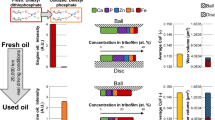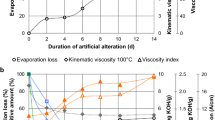Abstract
This research aims to track the chemical composition and fine structure of tribofilm, primarily considering sulfur- and phosphorus-related compounds in response to different applied loads and temperatures on the boundary lubrication regime, where the commercially formulated engine oil was adopted as lubricant. The results clearly reveal the formation of iron polyphosphate-rich tribofilm preferentially on the moving cast-iron surfaces, with increasing amount of FeS2/FeS2xOx species along with heavier load and higher temperature. Nevertheless, FeS2/FeS2xOx species gradually decrease rather than as the intermediate layer or increasingly concentrate on the substrate surface, which is greatly different from the previously reported tribofilm primarily consisting of zinc/iron polyphosphate and sulfide mixtures. More detailed information regarding how sulfur- and phosphorus-related species distribute spatially across the whole tribofilm thickness was given by ToF-SIMS technique.
Graphical Abstract















Similar content being viewed by others
Data availability
The data are available upon request from the corresponding authors.
References
Wong VW, Tung SC (2016) Overview of automotive engine friction and reduction trends-Effects of surface, material, and lubricant-additive technologies. Friction 4:1–28
Spikes H (2004) The history and mechanisms of ZDDP. Tribol Lett 17:469–489
Ueda M, Kadiric A, Spikes H (2019) On the crystallinity and durability of ZDDP tribofilm. Tribol Lett 67:123
Gosvami NN, Bares JA, Mangolini F, Konicek AR, Yablon DG, Carpick RW (2015) Mechanisms of antiwear tribofilm growth revealed in situ by single-asperity sliding contacts. Science 348(6230):102–106
Hsu CF, Barrirero F, Merz R, Stratmann A, Aboulfadl H, Facobs G, Kopnarski M, Mücklich F, Gachot C (2020) Revealing the interface nature of ZDDP tribofilm by X-ray photoelectron spectroscopy and atom probe tomography. Ind Lubr Tribol 72(7):923–930
Shimizu Y, Spikes HA (2016) The tribofilm formation of ZDDP under reciprocating pure sliding conditions. Tribol Lett 64(3):1–11
Soltanahmadi S, Morina A, van Eijk MCP, Nedelcu I, Neville A (2017) Experimental observation of zinc k dialkyl dithiophosphate (ZDDP)-induced iron sulphide formation. Appl Surf Sci 414:41–51
Dorgham A, Azam A, Morina A, Neville A (2018) On the transient decomposition and reaction kinetics of zinc dialkyldithiophosphate. ACS Appl Mater Interfaces 10(51):44803–44814
Zhou Y, Leonard DN, Guo W, Qu J (2017) Understanding tribofilm formation mechanisms in ionic liquid lubrication. Sci Rep 7(1):1–8
Wu YL, der Heide EV, He ZY (2022) Effect of sulfur on the hydrolytic stability and tribological properties of N-containing borate ester. Wear 504–505:204433
Liu S, Wang YX, Zhang XZ, Liu SJ, Ye Q, Liu WM (2023) Sulfur-containing carbon nanospheres as lubricant additives for antiwear and friction reduction. ACS Appl Nano Mater 6:18539–18547
Fang L, Korres S, Lamberti WA, Webster MN, Carpick RW (2023) What stress components drive mechanochemistry? A study of ZDDP tribofilm formation. Faraday Discuss 241:394–412
Lorenz M, Pawlicki AA, Hysmith HE, Cogen K, Thaker H, Ovchinnikova OS (2023) Direct multimodal nanoscale visualization of early phosphorus-based antiwear tribofilm formation. ACS Appl Mater Interfaces 4:35157–15166
Cyriac F, Yi TX, Poornachary SK, Chow PS (2021) Influence of base oil polarity on the tribological performance of surface-active engine oil additives. Tribol Lett 69:87
Li HG, Zhang YB, Li CH, Zou ZM, Nie XL, Chen Y, Cao HJ, Liu B, Zhang NQ, Said Z, Debnath S, Jamil M, Ali HM, Sharma S (2022) Extreme pressure and antiwear additives for lubricant: academic insights and perspectives. Int J Adv Manuf Technol 120:1–27
Luiz JF, Spikes H (2020) Tribofilm formation, friction and wear-reducing properties of some phorphorus-containing antiwear additives. Tribol Lett 68:75
Gorbatchev O, De Barros Bouchet M-I, Martin JM, Léonard D, Le-Mogne T, Iovine R, Thiebaut B, Héau C (2016) Friction reduction efficiency of organic Mo-containing FM additive associated to ZDDP for steel and carbon-based contacts. Tribol Int 99:278–288
Kusumoto TI (2006) Gasoline engine lubricant oil composition and manufacturing merhod therefor, E3279294B1
Zhang J, Spikes H (2016) On the friction mechanism of ZDDP antiwear film formation. Tribol Lett 63:24
Han T, Fan JC (2023) Ultrasonic measurement of contact stress at metal-to-metal interface based on a real rough profile through modeling and experiment. Measurement 217:113046
Cai ZB, Zhou Y, Qu J (2015) Effect of oil temperature on tribological behavior of a lubricated steel-steel contact. Wear 332–333:1158–1163
Ueda M, Spikes H, Kadiric A (2019) In-situ observations of the effect of the ZDDP tribofilm growth on micropitting. Tribol Int 138:342–352
Lorenz M, Pawlicki AA, Hysmith HE, Cogen K, Thaker H, Ovchinnikoca OS (2022) Direct multimodal nanoscale visualization of early phosphorus-based antiwear tribofilm formation. ACS Appl Mater Interfaces 14(30):35157–35166
Luiz JF, Spikes H (2020) Tribofilm formation, friction and wear-reducing properties of some phosphorus-containing antiwear additives. Tribol Lett 68:75
Kim YJ, Baik SI, Bertolucci-Coelho L, Mazzaferro L, Ramirez G, Erdermir A, Seidman DN (2016) Atom-probe tomography of tribological boundary films resulting from boron-based oil additives. Scr Mater 111:64–67
Kawada S, Sato K, Watanabe S, Sasaki S (2017) Lubricating property of cyano-based ionic liquids against hard materials. J Mech Sci Technol 31(12):5745–5750
Minifray C, Martin J, De Barros M, Le Mogne T, Kersting R, Hagenhoff B (2004) Chemistry of ZDDP tribofilm by TOF-SIMS. Tribol Lett 17:351–357
Crobu M, Rossi A, Mangolini F, Spencer ND (2012) Chain-length-identification strategy in zinc polyphosphate glasses by means of XPS and ToF-SIMS. Anal Bioanal Chem 403:1415–1432
Tse JS, Song Y, Liu ZX (2007) Effects of temperature and pressure on ZDDP. Tribol Lett 28:45–49
Kalin M, Viintin J (2001) High temperature phase transformation under fretting conditions. Wear 249:172–181
Acknowledgements
We acknowledge the support from the Doctoral Research Startup Foundation of Lanzhou College of Arts and Sciences (No. 2020-03).
Author information
Authors and Affiliations
Contributions
Yana Xia proposed the research investigation, analyzed data and drafted manuscript. Shuxia Zhang did the ToF-SIMS analysis. Zaizhou Wang and Chunxiang Zhang conducted manuscript revision. All authors reviewed the manuscript.
Corresponding authors
Ethics declarations
Conflict of interest
The authors declare that they have no competing interests or personal.
Ethical approval
This article does not include any studies involving humans or animals.
Additional information
Handling Editor: Maude Jimenez.
Publisher's Note
Springer Nature remains neutral with regard to jurisdictional claims in published maps and institutional affiliations.
Supplementary Information
Below is the link to the electronic supplementary material.
Rights and permissions
Springer Nature or its licensor (e.g. a society or other partner) holds exclusive rights to this article under a publishing agreement with the author(s) or other rightsholder(s); author self-archiving of the accepted manuscript version of this article is solely governed by the terms of such publishing agreement and applicable law.
About this article
Cite this article
Xia, Y., Zhang, S., Wang, Z. et al. New insight into tribofilm composition and structure of iron polyphosphate-rich tribofilm from formulated engine oil by ToF-SIMS. J Mater Sci (2024). https://doi.org/10.1007/s10853-024-09723-0
Received:
Accepted:
Published:
DOI: https://doi.org/10.1007/s10853-024-09723-0




